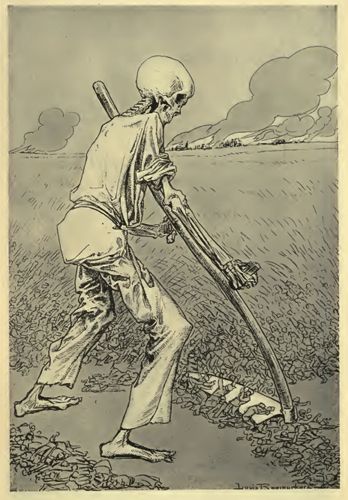
The Harvest is Ripe, Louis Raemaeker, 1914
This is one of the first of the Dutch cartoonist Louis Raemaeker’s works to appear after the start of World War One. In it we can see reflected his deep concern about the behaviour of the German troops after their invasion of Belgium. At the outbreak of war Raemaeker stopped painting and concentrated instead on using his pencil to create a series of devastating cartoons, many of which were published before any Official Reports.
This one was made soon after German troops crossed into the Belgian frontier on the evening of 3 August. In the book Raemaker’s Cartoon History of the War published in 1918 this cartoon was accompanied by the following text …
On the 4th of August,” says one witness, “at Herve I saw at about 2 o’clock in the afternoon, near the station, five Uhlans; these were the first German troops I had seen. They were followed by a German officer and some soldiers in a motor car. The men in the car called out to a couple of young fellows who were standing about thirty yards away. The young men, being afraid, ran off and then the Germans fired and killed one of them named D.” The murder of this innocent fugitive civilian was a prelude to the burning and pillage of Herve and of other villages in the neighborhood, to the indiscriminate shooting of civilians of both sexes, and to the organized military execution of batches of selected males. British Government Committee’s Report
References
J. Murray Allison, Raemaker’s Cartoon History of the War Vol. 1, The Century Co., New York, 1918, p.4
![]() Compiled by Geoff Barker, Research and Collection Services Coordinator, Parramatta Council Heritage Centre, 2014
Compiled by Geoff Barker, Research and Collection Services Coordinator, Parramatta Council Heritage Centre, 2014


